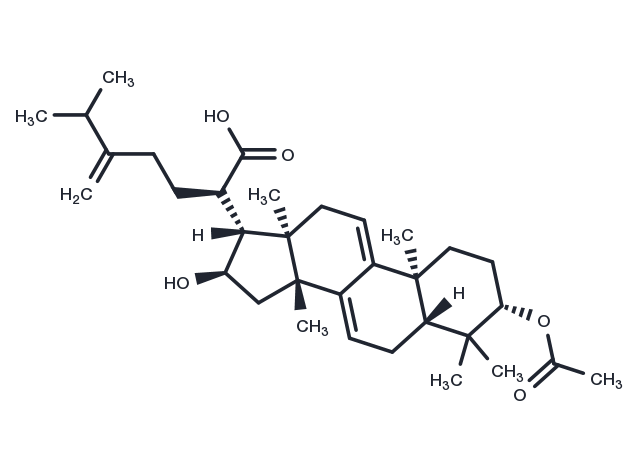Powder: -20°C for 3 years | In solvent: -80°C for 1 year


Dehydropachymic acid shows antiinflammatory activity.

| Pack Size | Availability | Price/USD | Quantity |
|---|---|---|---|
| 1 mg | In stock | $ 139.00 | |
| 5 mg | In stock | $ 392.00 | |
| 10 mg | In stock | $ 595.00 | |
| 25 mg | In stock | $ 949.00 | |
| 50 mg | In stock | $ 1,290.00 | |
| 1 mL * 10 mM (in DMSO) | In stock | $ 487.00 |




| Description | Dehydropachymic acid shows antiinflammatory activity. |
| In vitro | Here, we show that a characterized mixture of triterpenes extracted from P. cocos (PTE) and three purified triterpenes: pachymic acid (PA), Dehydropachymic acid (DPA) and polyporenic acid C (PPAC) suppress the proliferation of the human pancreatic cancer cell lines Panc-1, MiaPaca-2, AsPc-1 and BxPc-3. Moreover, the most effective compound, PA, only slightly affects the proliferation of HPDE-6 normal pancreatic duct epithelial cells. The anti-proliferative effects of PTE on BxPc-3 cells are mediated by the cell cycle arrest at G0/G1 phase. DNA microarray analysis demonstrated that PTE significantly downregulates the expression of KRAS and matrix metalloproteinase-7 (MMP-7) in BxPc-3 cells. In addition, PTE and PA suppress the invasive behavior of BxPc-3 cells. The inhibition of invasiveness by PTE and PA was associated with the reduction of MMP-7 at the protein level and the role of MMP-7 further confirmed by the gene silencing of MMP-7 which also suppressed the invasiveness of BxPc-3 cells. |
| Source |
| Molecular Weight | 526.75 |
| Formula | C33H50O5 |
| CAS No. | 77012-31-8 |
Powder: -20°C for 3 years | In solvent: -80°C for 1 year
DMSO: 5.27 mg/mL (10 mM)
You can also refer to dose conversion for different animals. More
bottom
Please see Inhibitor Handling Instructions for more frequently ask questions. Topics include: how to prepare stock solutions, how to store products, and cautions on cell-based assays & animal experiments, etc.
Dehydropachymic acid 77012-31-8 Autophagy Immunology/Inflammation Immunology/Inflammation related inhibit Inhibitor inhibitor
